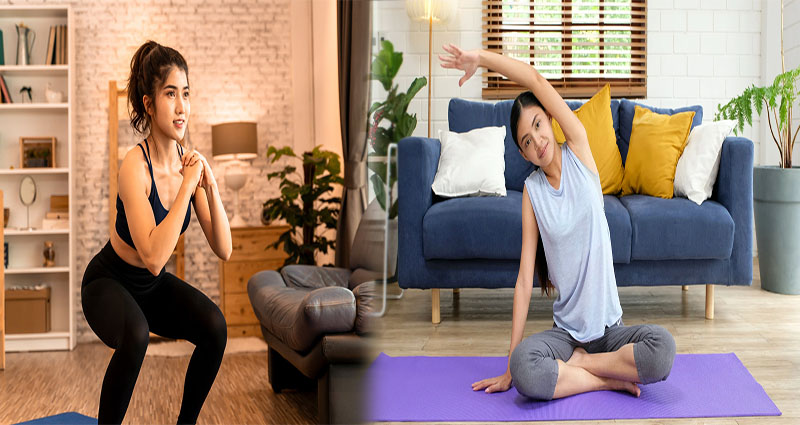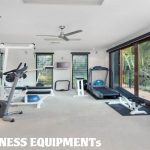I know it’s hard to get fit at home. You have busy lives and little time to spare, and you’re not sure if you can get the same results as if you went to the gym. Well, I’m here to tell you that with a little creativity and some good equipment in your house—plus some knowledge of how your body works—you can absolutely be fit in no time at all!
Do something active every day.
You should aim for at least 30 minutes of moderate-intensity physical activity on most days of the week. You can break that up into shorter sessions, but try to get your heart rate up for at least 10 minutes at a time. If you’re not used to exercising regularly, start with five minutes and build up from there.
To help you stay motivated and make sure you’re getting enough exercise, set aside some time each day–even if it’s just a half hour–to do something active: take a walk around the block or go for a jog (or even just run in place). If possible, schedule this as part of your daily routine so it becomes as much a part of life as brushing your teeth or putting on makeup before work every morning; once this becomes second nature it will be easier to stick with over time!
Find a workout you love.
- The most important thing is to find a workout that you actually enjoy. If it’s something that makes you feel good and gives your body the exercise it needs without feeling like a chore, then great! If not, don’t do it.
- Don’t do something just because everyone else is doing it or because it’s supposed to be good for you (if done right). If there are other options available, try them out first before making up your mind about what works best for YOU as an individual person in YOUR specific situation with YOUR specific goals and needs!
- And lastly: if at any point during an exercise routine–or even after several weeks of regular practice–it starts feeling like hard work rather than enjoyable recreation…then maybe try another method?
Use in-home equipment.
The first thing you need to do is make sure that the equipment you have is set up properly. If it’s not, there’s no point in using it at all! To set up a treadmill or elliptical machine, follow these steps:
- Adjust the height of your treadmill so that when you stand on it barefoot (with no shoes), there is about one inch of clearance between your toes and the front edge of the treadmill deck. This will ensure that any impact from running isn’t absorbed by soft tissue instead of bone–which could lead to injuries such as stress fractures or shin splints.
- Set up an elliptical so that when standing on its pedals with both feet parallel together (and facing forward), there should be four inches between each pedal and its adjacent handlebars; this distance provides enough room for proper form while working out without creating excess stress on any part of your body due to tightness or strain induced by improper positioning during exercise routines using this type of equipment (usually called cross-training).
Get some cardio in your routine.
- Cardio is the most important part of any fitness routine.
- Cardio helps you lose weight, and it helps you live longer.
- Cardio can be running, swimming or cycling – whatever gets your heart pumping!
- Cardio helps with stress relief because it releases endorphins in the brain which make us feel good about ourselves and our lives in general.
Lift weights for strength training.
Lifting weights is a great way to build muscle, which can help you lose weight and get stronger. It’s also known to lower your risk of osteoporosis, improve your posture and body shape.
Lifting weights comes with some risks, though–if you don’t know what you’re doing or don’t use proper form while lifting heavy objects (such as barbells), there’s potential for injury. Make sure that if you decide to lift weights at home that:
- You have access to proper equipment (and know how to use it)
- Your workout plan includes exercises that focus on different parts of the body so that no one area gets too much attention
Do high-intensity interval training (HIIT).
HIIT is a great way to get fit, and it doesn’t require any equipment. HIIT stands for high-intensity interval training–an exercise form that alternates between periods of intense activity and short rest periods. For example: you could sprint as fast as possible for 30 seconds, then walk slowly for 60 seconds before repeating the cycle again and again until your heart rate drops below 100 beats per minute (the point at which your body needs oxygen). You can do HIIT with a variety of exercises including running, cycling and swimming–and if you don’t have access to any kind of equipment at home, there are plenty of resources online explaining how to create your own workout routines from scratch without having any fancy machines lying around!
Count calories burned with a heart rate monitor.
Counting calories burned with a heart rate monitor is a great way to keep tabs on your progress. It’s important to remember, however, that this method doesn’t account for the type of activity you’re doing–only how much energy you expend during it. So if you’re lifting weights or doing cardio (running/cycling), be sure to factor in any additional calories burned as well.
Here’s how:
- Set up your fitness tracker so it measures both steps taken and heart rate throughout the day (or night). If yours doesn’t have this feature built in, consider buying one that does! The best ones will also track sleep patterns and quality so they give even more insight into how many calories were actually burned throughout the day rather than just during exercise sessions.* When working out at home with free weights or dumbbells: Keep track of sets completed and repetitions completed per set; then add those numbers together along with any other exercises performed during that session (elevated squats, push-ups) before multiplying by three since each workout should last about 30 minutes total including warm-up time.* For example: Let’s say I do 15 reps per set on bicep curls followed by 20 lateral raises; then add all these together along with my warmup sets until reaching 60 total reps per workout session which would mean each set takes me approximately 20 seconds worth of time spent lifting weights (15 x 3 = 45 + 20 = 65 seconds). Multiply 65 seconds x 3 = 195 seconds total spent lifting weights each day – which breaks down into roughly 4 minutes 40 seconds worth of work outs per week based solely off calculations alone…
It’s easy to get fit at home if you have the right tools and know what to do with them!
The first step to getting fit at home is knowing what you want to achieve. If you’re trying to lose weight, then it’s important that your workouts are tailored towards burning fat and toning muscle rather than building strength.
If you have any injuries or health conditions that need managing, make sure that any exercise program includes modifications so as not to aggravate them further or cause more damage than good.
Also keep in mind that while working out at home has its advantages (such as saving money), this doesn’t mean that all fitness equipment is created equal! When buying new equipment for use in the comfort of your own home, make sure it has been tested by experts and meets certain industry standards before investing in something that may fall short when put under pressure (and trust us–you’ll know if something isn’t up to scratch).
We hope this article has given you some ideas of how to get fit at home. If you’re someone who loves being active, but doesn’t have access to a gym or equipment, then this is perfect for you! We know that it can be tough to find time in our busy lives for exercise and workouts–but if we all make an effort to get moving every day by doing something active (even if it’s just going on a walk with friends), then we’ll all be healthier people in the long run. And remember: there are no excuses not to get started today!












